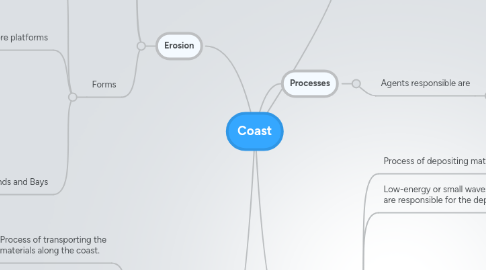
1. Transportation
1.1. Process of transporting the materials along the coast.
1.2. Current responsible is the longshore current.
1.2.1. Longshore currents are generated by winds, tides and waves and flow parallel to the coast.
1.2.2. Plays a crucial role in transporting materials along the coast due to the direction in which they flow.
1.2.3. Waves approach the coast at an angle, depending on the direction of the wind.
1.2.3.1. Sediments are carried to the coast by swash, and the backwash, due to gravity, carried the sediments back to the sea at a right angle to the coast.
1.2.3.2. This movement, when repeated, gives a zig-zag motion to the sediments along the coast.
2. Erosion
2.1. Process of removing materials from the coast
2.2. High-energy waves erode the rocks and carry away the eroded material
2.3. Forms
2.3.1. Cliffs
2.3.1.1. High, steep rock face along the coast
2.3.1.2. Formed when the rocky coasts get repeatedly washed by waves causing the rock to weaken and erode
2.3.1.3. Size and shape depends on rock type and wave energy
2.3.2. Shore platforms
2.3.2.1. Gently sloping or flat surface forms at the base of the cliff
2.3.2.2. During high tides, the water cover the shore platform and erodes the cliff at its base. During low tides, sediments are deposited on the gentle slope as it is now exposed.
2.3.3. Headlands and Bays
2.3.3.1. Caused when the coastal rocks are repeatedly washed by the waves, resulting in uneven coastlines.
2.3.3.2. Coastal rocks comprise of different materials due to which, they have varied resistance to erosion.
2.3.3.2.1. The more resistant rocks protrude into the sea to form headlands and inward curving rocks form bays.
2.3.3.3. When waves approach a headland, they tend to bend and concentrate more towards this landform.
2.3.3.3.1. Bends form because some waves slow down when they reach the shallow waters in front of a headland while the other waves continue to head at the same speed. This bending of waves is called refraction.
2.3.3.3.2. Due to refraction, wave energy concentrates on the headlands, weakening along the bays, leading to deposition of materials along the bay.
3. Part of a piece land which adjoins and merges with the sea
4. Deposition
4.1. Process of depositing material on the coast.
4.2. Low-energy or small waves and long-shore currents are responsible for the deposition of materials
4.3. Results in accumulation of materials by over time and forms landform like
4.3.1. Beaches
4.3.1.1. Shape and size of beaches depends on the weather as well.
4.3.1.1.1. Calm weather build up materials Stormy weather remove materials
4.3.1.1.2. Different materials produce different inclination or slopes
4.3.2. Spits and Tombolos
4.3.2.1. Spits is a long narrow ridge of sand, with one end attached to the mainland and the other protruding into the sea.
4.3.2.2. A spit is formed by materials deposited by long-shore currents reaching a bay or a bend, where they encounter shallow and sheltered water.
4.3.2.3. Tombolos are extension of a spit, which joins an offshore island to the mainland or even one island to another island.
4.3.2.4. Tombolos, like spits, are primarily comprised of sand.
5. Processes
5.1. Agents responsible are
5.1.1. Waves
5.1.1.1. Rising and falling movement on the suface of water
5.1.1.2. Two factors affecting the size
5.1.1.2.1. Wind Energy
5.1.1.2.2. Fetch
5.1.1.3. Forward movement called swash Backward movement called backswash
5.1.1.4. High Energy waves called destructive waves Low Energy waves called constructive waves
5.1.2. Currents
5.1.2.1. The flow of water moving either vertically or horizontally
